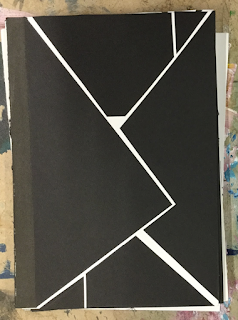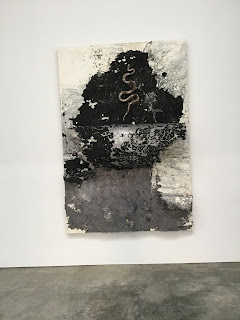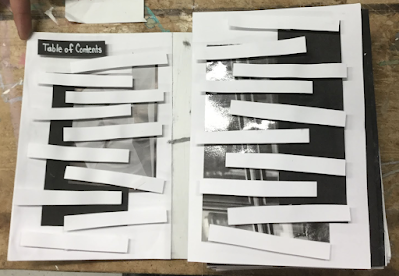Derek Brueckner's VISUAL LANGUAGE Course
Often a single example of work may not demonstrate all the required objectives for a particular assignment. Instead students should collectively consider: the required objectives for each assignment, the multiple examples presented on this blog and during in class presentations. As well ideas discovered through a student's independent research in combination with various examples and ideas presented by instructor will ultimately be the best approach for synthesizing ideas and reaching the requirements (and unique outcome) for any particular course project.
Assignment 1: Black & White DIY Booklet Assignment
Examples of Some Individual Pages for DIY Booklet Assignment:
(See assignment text with more information after examples below)
The individual assignments examples below demonstrate a good variety but also offer different levels of strengths and different levels in the execution of ideas. If people have any questions about the text or require clarification about the specific strengths in the following individual examples please consult instructor.
The individual assignments examples below demonstrate a good variety but also offer different levels of strengths and different levels in the execution of ideas. If people have any questions about the text or require clarification about the specific strengths in the following individual examples please consult instructor.
Summary of Assignment:
The Black and White Abstract DIY Booklet Assignment will require using a variety of 2D art materials and periodically relief (3D art materials) with individual pages that will be sequenced together to present a booklet.
Collectively this assignment will emphasize various implications of space (flat space to illusions of deep space), compositional strategies, physicality of materials and overall innovative and experimental use of materials.
Editing individual pages and overall assignment will be inevitable and is required!
Some Suggested Materials to use for Assignment:
Some Suggested Materials to use for Assignment:
Black and white paper (for collage or surfaces for wet and dry media), black and white paint, black & white markers, black & white string, or any other materials which are black or white.
Many materials could be painted black and white. Many materials not suggested above could be a potential option, consult with instructor for clarification regarding materials for the DIY Booklet Assignment (Assignment 1)
Requirements for the B & W Booklet:
Research and Present the Following 9 Points:
The following points could be included in the table of contents but there could be other points included in table of contents as well. See at bottom of this post for examples of Table of Contents.
1) Lines and Shapes (organic & geometric)
2) Light, shadow and value (minor part of assignment)
3) Space (Optical and Border Parameters of each page)
4) Investigations of a variety of Textures (illusionistic and tactile surfaces and overall consideration for physicality of materials)
5) Logics of Composition that include analytical and intuitive processes of composing 2D and 3D (relief) elements
Consider and Demonstrate: awareness of the boarder for each page (how do elements interact with boarder edge of each page?), negative positive space, flow and movement of elements, balanced composition using primarily asymmetrical layouts along with some symmetrical compositional layouts.
Consider and Demonstrate: awareness of the boarder for each page (how do elements interact with boarder edge of each page?), negative positive space, flow and movement of elements, balanced composition using primarily asymmetrical layouts along with some symmetrical compositional layouts.
6) Scale: consider the scale of various elements in composition and context of materials
2D and relief (3D) art materials
7) Variety in the use of material and sensibilities- explore a combination of controlled/precise and expressive/experimental use of materials. Collectively and on many individual pages assignment should include a combination of wet and dry art materials.
8) Sequence created in entire booklet: Collective experience created form page to page in this time-based work.
9) Binding and Table of Contents
Many of the ideas presented in the above points can overlap with each other and can simultaneously be presented in a variety of ways with in a single page. Make sure all the above ideas are collectively presented in the booklet's pages in some way.
Use the above information to create a frame work for your Table of Contents
Other Assignment Requirements to Follow:
Size: Minimum size for each page in the booklet is 8.5 x 5.5 inches
Number of Pages: 10 double sided pages or 20 single sided pages
10 double sided pages together plus a cover (include table of contents as page 1 of the 10 double sided pages) Presenting 20 single sided pages is also an option. Either way there needs to be 20 individual pages of art work.
* Table of Contents and Pages Numbers: Number pages 1 to 20 with pages numbers corresponding to the table of contents
Cover and Binding: Consider the overall visual language of the binding and cover in a DIY (do it yourself) kind of way. Allow the binding and cover to be simple but functional. Functional choices can often direct aesthetics (Function = Form)
Make sure the booklet can be easily flipped through.
Binding techniques and materials may include: thread, glue, staples, tape, rope, ribbons, binder rings, bolts, or grommets. Many people use twine, ribbon or binder rings. Please make sure the materials used to bind the booklet have been covered with black and/or white materials (integrate the design of the binding into work)
Cover materials may include: fabric, tape, cardboard, illustration board, foam core, thick paper, and acetate.
Name on Booklet: present (printed neatly) your first and last name either on the front cover or in the table of contents Consider your name as part of the design- think about options regarding: text font, scale and location of name (Please do NOT indicate your student number on this or any other assignment)
Size: Minimum size for each page in the booklet is 8.5 x 5.5 inches
Number of Pages: 10 double sided pages or 20 single sided pages
10 double sided pages together plus a cover (include table of contents as page 1 of the 10 double sided pages) Presenting 20 single sided pages is also an option. Either way there needs to be 20 individual pages of art work.
Cover and Binding: Consider the overall visual language of the binding and cover in a DIY (do it yourself) kind of way. Allow the binding and cover to be simple but functional. Functional choices can often direct aesthetics (Function = Form)
Make sure the booklet can be easily flipped through.
Binding techniques and materials may include: thread, glue, staples, tape, rope, ribbons, binder rings, bolts, or grommets. Many people use twine, ribbon or binder rings. Please make sure the materials used to bind the booklet have been covered with black and/or white materials (integrate the design of the binding into work)
Cover materials may include: fabric, tape, cardboard, illustration board, foam core, thick paper, and acetate.
Research potential homemade binding methods on line or in books at the Architecture/Fine Arts Library. Use a method of binding that allows for some technical growth but does not become overwhelming.
Here again which ever combination of options and materials used for the binding and cover consider the over all visual language of those material choices and techniques in the overall design.
Name on Booklet: present (printed neatly) your first and last name either on the front cover or in the table of contents Consider your name as part of the design- think about options regarding: text font, scale and location of name (Please do NOT indicate your student number on this or any other assignment)
Before the Booklet is Bound Together Consider the Following Ideas:
Consider how the sequence/order of the pages is viewed as a person flips through the book. What are the visual rhythms or relationships from page to page as a person looks through the book?
How and where is the best context for the pages with the complex compositions and where are the best places for the more minimalist compositions?
Are there too many minimalist compositions and or do many of the compositions require more overlapping or interaction of shapes and materials? What pages require editing?
Remember as previously discussed:
collectively and at times on individual pages the booklet should include a combination of wet and dry materials with various black and white mediums and materials. Overall this assignment will emphasize various use of space, compositional strategies, physicality of materials and innovate use of materials.
collectively and at times on individual pages the booklet should include a combination of wet and dry materials with various black and white mediums and materials. Overall this assignment will emphasize various use of space, compositional strategies, physicality of materials and innovate use of materials.
(The examples of pages presented below function as a general guide or starting point but do not cover all the assignment requirements)

GRADING CRITERIA:
Resolved Experimentation and Innovation in Assignment 20% *
Variety and Unity of Materials (2D and some 3D materials) 30%
Physicality of Materials 10%
Variety and Unity of Formal Languages 35%
(Line, Shape, Black & White, Composition and Space)
Variety and Unity created in entire Sequence of Booklet 5% *
All of the above grading criteria requires and includes Revisions & Editing in assignment
See Points 1 to 9 and other text and examples above.
Subscribe to:
Comments (Atom)






























































































